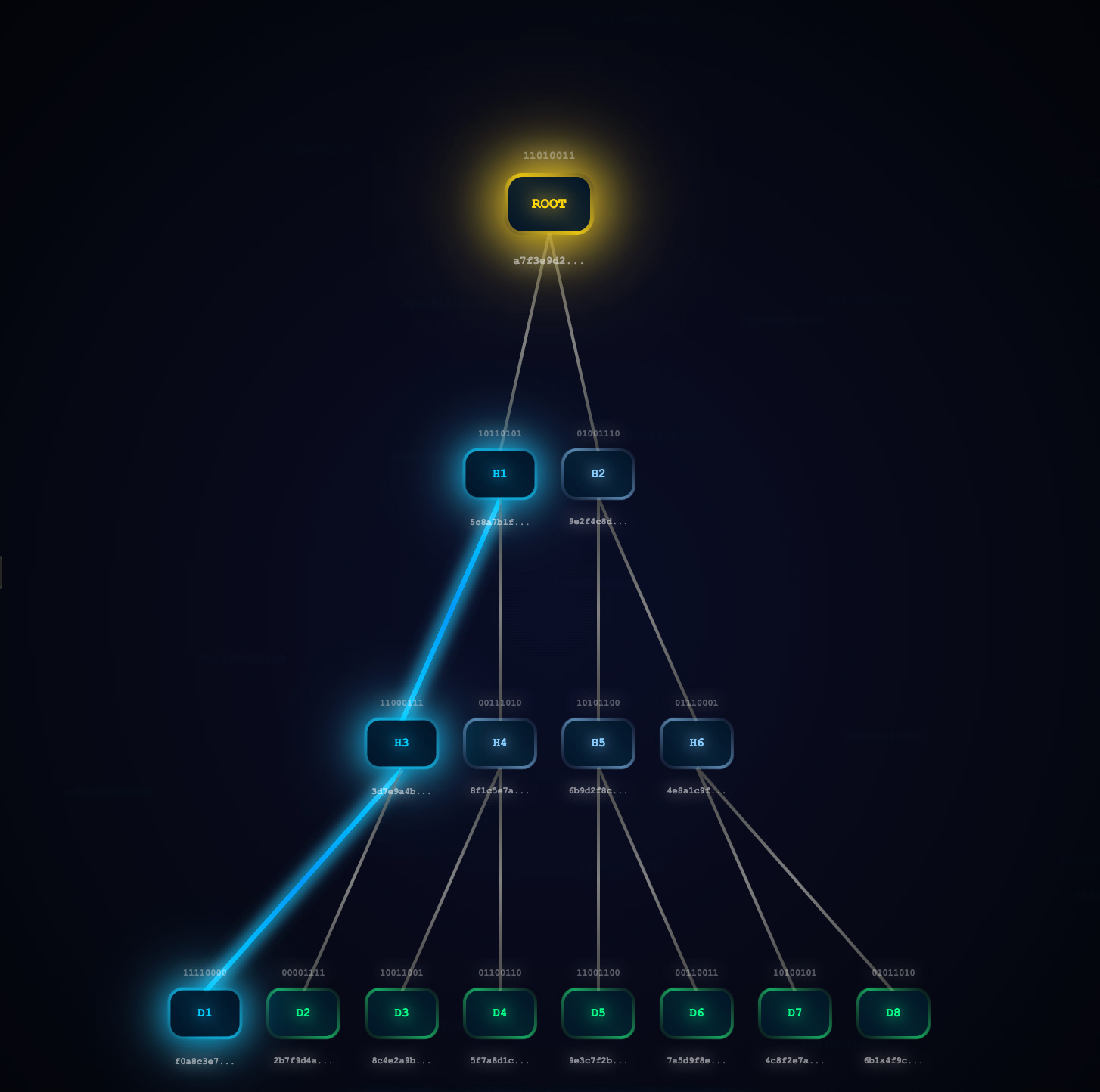In our last post, we discussed about how you can compare two large datasets for integrity using Merkle trees.
The beauty of Merkle Trees lies in their efficiency: you can verify that a specific piece of data belongs to a larger dataset by providing just a small "proof" - a path of hashes from the leaf to the root, rather than the entire dataset.
In this post, let’s dive into the implementation details and understand how we can leverage Merkle trees in real-world.
Naive Implementation
Let’s start with a naive implementation for Merkle Trees.
Core Structure
type Node struct {
Hash []byte
Data []byte // Only populated for leaf nodes
Left *Node
Right *Node
}
type MerkleTree struct {
Root *Node
Leaves []*Node
}The structure is straightforward - each node contains a hash and optional data (populated only for leaf nodes), with pointers to left and right children. The Merkle Tree maintains references to both the root and all leaf nodes.
Tree Construction Process
The construction follows these steps:
Create Leaf Nodes: Each data block is hashed using SHA-256
Build Tree Bottom-Up: Recursively combine pairs of nodes
Handle Odd Numbers: Duplicate the last node in case of odd number of nodes
Combine Hashes: Concatenate child hashes and hash the result
func buildTreeRecursive(nodes []*Node) *Node {
if len(nodes) == 1 {
return nodes[0]
}
// Handle odd number of nodes by duplicating the last one
if len(nodes)%2 == 1 {
nodes = append(nodes, nodes[len(nodes)-1])
}
// Build parent level by combining pairs
parentLevel := make([]*Node, 0)
for i := 0; i < len(nodes); i += 2 {
left := nodes[i]
right := nodes[i+1]
combinedHash := append(left.Hash, right.Hash...)
hash := sha256.Sum256(combinedHash)
parent := &Node{
Hash: hash[:],
Left: left,
Right: right,
}
parentLevel = append(parentLevel, parent)
}
return buildTreeRecursive(parentLevel)
}Proof Generation
The proof generation attempts to create a path from a leaf to the root by collecting sibling hashes at each level. This allows someone to verify a piece of data belongs to the tree without having the entire dataset.
func (mt *MerkleTree) GenerateProof(index int) ([][]byte, error) {
if index < 0 || index >= len(mt.Leaves) {
return nil, errors.New("index out of range")
}
proof := make([][]byte, 0)
// Navigate from leaf to root, collecting sibling hashes
currentIndex := index
currentLevel := mt.Leaves
for len(currentLevel) > 1 {
// Handle odd number of nodes
if len(currentLevel)%2 == 1 {
currentLevel = append(currentLevel, currentLevel[len(currentLevel)-1])
}
// Find sibling
var siblingIndex int
if currentIndex%2 == 0 {
siblingIndex = currentIndex + 1
} else {
siblingIndex = currentIndex - 1
}
proof = append(proof, currentLevel[siblingIndex].Hash)
// Move to parent level
currentIndex = currentIndex / 2
// Rebuild parent level
parentLevel := make([]*Node, 0)
for i := 0; i < len(currentLevel); i += 2 {
parentLevel = append(parentLevel, findParent(currentLevel[i], currentLevel[i+1], mt.Root))
}
currentLevel = parentLevel
}
return proof, nil
}While the naive implementation is good enough to demonstrate how Merkle trees work, it isn’t good enough to be used in the real-world.
Let’s dive into the problems with this existing implementation and what we can do to overcome it.
Problems with Naive Implementation
Broken Proof Verification
func VerifyProof(dataBlock []byte, proof [][]byte, rootHash []byte) bool {
hash := sha256.Sum256(dataBlock)
currentHash := hash[:]
for _, siblingHash := range proof {
// We don't know if sibling is left or right!
combinedHash1 := append(currentHash, siblingHash...)
hash1 := sha256.Sum256(combinedHash1)
combinedHash2 := append(siblingHash, currentHash...)
_ = sha256.Sum256(combinedHash2) // This is never used!
// We'll need to try both possibilities when verifying
// This is clearly not ideal!
currentHash = hash1[:]
}
return string(currentHash) == string(rootHash)
}The Problem: The function computes both possible hash combinations (current+sibling and sibling+current) but only uses the first one. This means verification will fail roughly 50% of the time, even for valid proofs.
The fundamental issue stems from how cryptographic hash functions work: Hash(A + B) ≠ Hash(B + A). Hence we need to understand the correct order, to be able to confirm if its a valid proof.
The Solution: Proofs must include directional information (left/right).
Inefficient Proof Generation
func findParent(left, right, root *Node) *Node {
if root == nil {
return nil
}
if root.Left == left && root.Right == right {
return root
}
if found := findParent(left, right, root.Left); found != nil {
return found
}
return findParent(left, right, root.Right)
}The Problem: For each level of the tree, the code performs a full tree traversal using findParent. This creates O(n²) complexity instead of the expected O(log n).
The Solution: Navigate directly from leaf to root using parent pointers will allow us better time complexity of O(log n).
Memory Inefficiency
The implementation stores complete subtrees during proof generation:
// Rebuild parent level
parentLevel := make([]*Node, 0)
for i := 0; i < len(currentLevel); i += 2 {
parentLevel = append(parentLevel, findParent(currentLevel[i], currentLevel[i+1], mt.Root))
}
currentLevel = parentLevelThe Problem: This reconstructs entire tree levels in memory, consuming O(n) space for what should be an O(log n) operation.
Improved Implementation
Fixed Proof Verification with Directional Information
The Problem: The original implementation couldn't determine whether a sibling hash should be on the left or right during verification, leading to ~50% failure rate.
The Solution: Introduced ProofElement structure with explicit directional information:
type ProofElement struct {
Hash []byte
IsLeft bool // true if this hash should be on the left during verification
}O(log n) Proof Generation with Parent Pointers
The Problem: Original implementation used O(n²) tree traversals for each proof generation.
The Solution: Added parent pointers and direction flags to enable direct navigation:
type Node struct {
Hash []byte
Data []byte
Left *Node
Right *Node
Parent *Node // Added for efficient navigation
IsLeft bool // Track position in parent
}Memory Efficiency and Resource Management
The Problem: Original implementation rebuilt entire tree levels in memory.
The Solution: Direct navigation eliminates unnecessary memory allocation:
func (mt *MerkleTree) GenerateProof(index int) ([]ProofElement, error) {
if index < 0 || index >= len(mt.Leaves) {
return nil, fmt.Errorf("index %d out of range [0, %d)", index, len(mt.Leaves))
}
proof := make([]ProofElement, 0)
current := mt.Leaves[index]
// Navigate from leaf to root using parent pointers - O(log n)
for current.Parent != nil {
parent := current.Parent
var sibling *Node
// Get sibling node
if current.IsLeft {
sibling = parent.Right
} else {
sibling = parent.Left
}
// Add sibling to proof with correct direction
proof = append(proof, ProofElement{
Hash: sibling.Hash,
IsLeft: !current.IsLeft, // Sibling's position relative to current
})
current = parent
}
return proof, nil
}Secure Cryptographic Operations
The Problem: Original used string comparison for hashes, vulnerable to timing attacks.
The Solution: Implemented constant-time comparison and proper hash handling:
func VerifyProof(dataBlock []byte, proof []ProofElement, rootHash []byte) bool {
if dataBlock == nil || rootHash == nil {
return false
}
// Start with hash of the data block
hash := sha256.Sum256(dataBlock)
currentHash := hash[:]
// Apply each proof element with correct ordering
for _, element := range proof {
var combinedHash []byte
if element.IsLeft {
// Sibling hash goes on the left
combinedHash = make([]byte, 0, len(element.Hash)+len(currentHash))
combinedHash = append(combinedHash, element.Hash...)
combinedHash = append(combinedHash, currentHash...)
} else {
// Sibling hash goes on the right
combinedHash = make([]byte, 0, len(currentHash)+len(element.Hash))
combinedHash = append(combinedHash, currentHash...)
combinedHash = append(combinedHash, element.Hash...)
}
hash := sha256.Sum256(combinedHash)
currentHash = hash[:]
}
// Use constant-time comparison to prevent timing attacks
return subtle.ConstantTimeCompare(currentHash, rootHash) == 1
}A timing attack exploits variations in execution time to infer information about secret data being processed. The attack works because many algorithms have execution paths that depend on the data being processed - and these timing differences can leak information about that data.
An attacker could:
Generate fake proofs with different root hash candidates
Measure verification time for each candidate
Extract the real root hash byte by byte based on timing differences
Now with the improved implementation, let’s check with how much improvement we have gained:
As we can see, we can see a huge improvement in proof function because of the changes above. You can see a huge increase in performance in the optimised version:
Tree Size → Speedup Factor
100 → 253x
1,000 → 13,500x
10,000 → 103,400x
100,000 → 60,300x
These are just basic optimisations that bring our implementation closer to a production implementation. However, we can do more(let me know in comments if you want me to go into that).
Hopefully this article along with the previous one, gave you a good insight and understanding into Merkle Trees and how they can be implemented in the real-world.
Feel free to drop me a feedback!
👉 Connect with me here: Pratik Pandey on LinkedIn
👉 Find the code on Github here: Merkle Trees









Hey awesome post! I also had a post on Merkle Trees. Feel free to check it out. https://open.substack.com/pub/ahmazin/p/merkle-trees?r=1tezps&utm_medium=ios